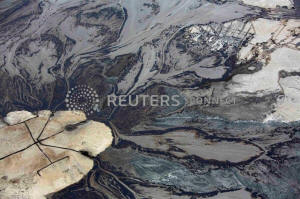Canada has big plans to use hydrogen to cut emissions - and produce more
oil
 Send a link to a friend
Send a link to a friend
 [September 04, 2020]
By Rod Nickel and Steve Scherer [September 04, 2020]
By Rod Nickel and Steve Scherer
WINNIPEG, Manitoba/OTTAWA (Reuters) -
Canada's main crude-producing province Alberta looks to use hydrogen to
fuel expansion of its oil sands without increasing emissions, even as
Prime Minister Justin Trudeau promises strong action against climate
change, officials with the two governments said.
Alberta will announce no later than October a strategy to develop "blue
hydrogen" as a cleaner alternative to using natural gas to extract crude
at steam-driven oil sands sites, Associate Minister of Natural Gas Dale
Nally told Reuters in an interview.
Deploying cleaner feedstock will allow Alberta to produce more oil
without exceeding its 100 megatonne annual limit on provincial carbon
emissions, Nally said.
"Hydrogen will allow us to continue to move the bar and reduce the
carbon intensity of the oil sands until you get to a point where there
is no difference in (greenhouse gases) in conventional oil and oil
sands," he said, adding that Alberta's hydrogen plan is synchronized
with Ottawa's.

"Reducing the carbon intensity of the oil sands would allow of course
more expansion."
Blue hydrogen is produced from natural gas, with the carbon byproduct
captured and stored.
A green agenda to be launched by Trudeau this month is expected to map
out a course to the 2050 zero-emissions target, and likely to include a
strategy describing hydrogen as a "net-zero moon shot" for the petroleum
sector, said a government source familiar with the federal plan.
According to a draft 14-page summary of the federal strategy seen by
Reuters, hydrogen will leverage the fossil fuel sector's "expertise and
infrastructure... to decarbonize and diversify into a leading global
clean fuels exporter," the document reads.
"If (Alberta) is staying under their 100 megatonne cap, how they choose
to do that, or how they choose to employ hydrogen to do that, isn't
really our concern," said the government source.
[to top of second column]
|

Oil goes into a tailings pond at the Suncor oil sands operations
near Fort McMurray, Alberta, September 17, 2014. REUTERS/Todd Korol/File
Photo

"Cleaning up the oil and gas sector is going to be a necessary event
if we are going to meet our 2050 target" of net-zero emissions, the
source added.
Oil sands growth has slowed, with Teck Resources scrapping plans for
a new mine this year and the pandemic crushing oil demand, resulting
in temporary production cuts.
The hydrogen plans raise flags for some environmental groups
familiar with the federal strategy. Some major investors like
Norway's $1 trillion wealth fund have shunned oil sands companies
because of their tarnished environmental reputation.
"Hydrogen is like a lifeboat for (the oil sands)," said Julia Levin,
climate and energy program manager at Environmental Defence, about
the federal strategy. "It's a significant fossil fuel subsidy at a
time when we're making no progress on eliminating fossil fuels."
The federal government's draft plan - three years in the making -
says several provinces could produce hydrogen, some using renewable
energy, and by 2050 the industry could create 100,000 jobs, generate
more than C$5 billion in annual revenue and reduce annual greenhouse
gas emissions by 100 megatonnes.
Some say hydrogen is not likely to transform the oil industry
anytime soon.
"We still don't have a good understanding of the economics, how much
it's going to cost and what we're going to use it for," said Allan
Fogwill, chief executive of the Canadian Energy Research Institute.
(Reporting by Steve Scherer in Ottawa and Rod Nickel in Winnipeg,
Manitoba; Editing by Lisa Shumaker)
[© 2020 Thomson Reuters. All rights
reserved.] Copyright 2020 Reuters. All rights reserved. This material may not be published,
broadcast, rewritten or redistributed.
Thompson Reuters is solely responsible for this content.
 |